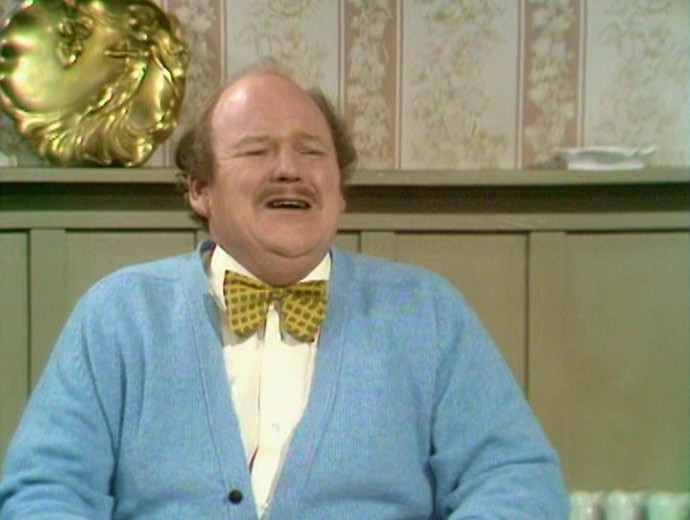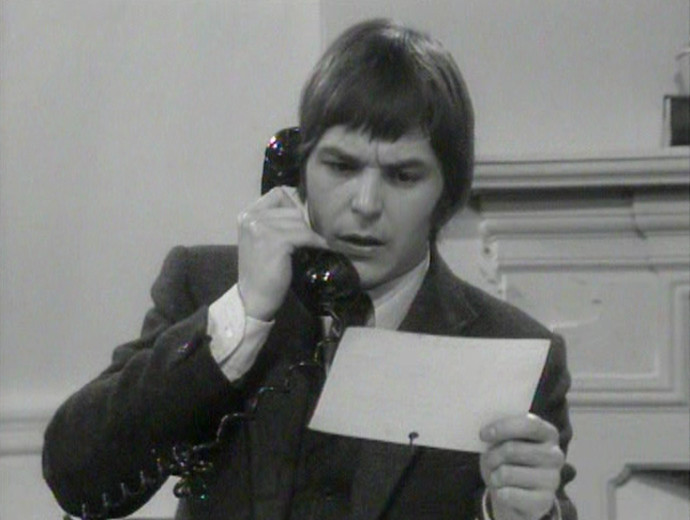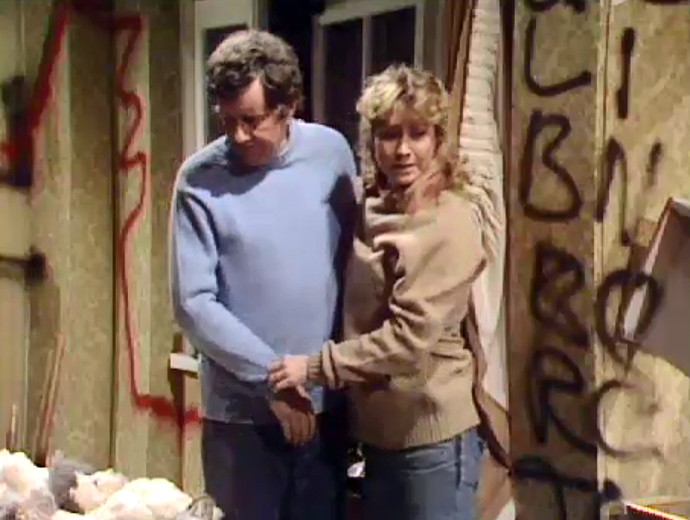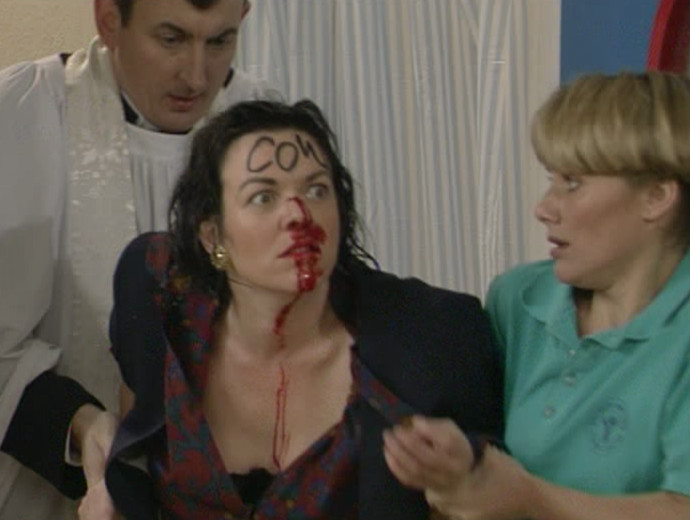
In the penultimate part of this series, we examined the full wrath of John Cleese. Today, to round things up, I want to investigate his softer side. The softer side that nonetheless involves a sharp jab at his fellow professionals, because this is John Cleese: the man who deliberately broadcast David Frost’s telephone number to the nation because he thought it was funny.
And a character like Mr. Davidson – someone who is the embodiment of anti-comedy – is the perfect vehicle Cleese can use to slag off some lazy jokes.
* * *
Let’s take a look at that climactic scene again. Here is Mr. Davidson desperately trying to get the room back on board with a crap joke… while Collier and Stuart-Clark kick him back into the dirt.
MR. DAVIDSON: ‘Ere Doctor, you’ll like this one. A young lady goes to the surgery, doctor examines her, and he says “I’ve got some good news for you, Mrs. Brown. “Miss Brown, doctor…”, she says.
PAUL COLLIER: Miss Brown? Miss Brown? Isn’t she married?
MR. DAVIDSON: No, no, that’s right, yeah…
DICK STUART-CLARK: Er, the doctor thought she was married?
MR. DAVIDSON: Er, yeah, yeah…
DICK STUART-CLARK: Why, was she pregnant?Mr. Davidson tries to shut him up with a hand movement.
DICK STUART-CLARK: Er, sorry.
MR. DAVIDSON: That’s alright.
DICK STUART-CLARK: Go on.
MR. DAVIDSON: So… “Miss Brown”, she says. “Oh”, says the doctor. “In that case I’ve got some bad news for you! Ahahaha! I’ve got some bad news for you…The room is silent.
Ah, that was deeply satisfying. Let me just enjoy that again for a moment.
Right, I’m done. Now, step back eight weeks to 4th April 1971, and the episode Congratulations, It’s A Toad, written by Graeme Garden and Bill Oddie. And what do we find?
SUE MAXWELL: Mrs. Walters’ on the phone about the results of her pregnancy test.
DR. UPTON: Oh yes, thank you.He picks up the phone, and dials.
DR. UPTON: Hello, Mrs. Walters? Well, it’s good news, Mrs. Walters… what? Oh sorry, Miss Walters? Oh well it’s bad news, I’m afraid…
In other words: a joke which John Cleese is holding up as an example of terrible lazy comedy was used for real by the series eight weeks previously.1


I mean, I have no proof. But isn’t it so easy to imagine Cleese watching that episode, scowling at the use of that old chestnut, and resolving to make fun of Garden and Oddie’s script by putting the same joke into the mouth of a joker character who is supposed to be the least funny person in the world?
To back up this theory2, I wish to quote Graham Chapman’s A Liar’s Autobiography, speaking about writing Doctor at Large with Bernard McKenna:
“The next day Bernard and I had got as far as:
‘INT. HOSP. CORRIDOR. DAY.
ENTER PROF. LOFTUS
PROFESSOR LOFTUS (brusquely): Morning Matron……when we were sidetracked by the thought that if you used the word ‘bedpan’ it always brought gales of laughter from the older ladies in the studio audience. We had resented this easy laugh in other people’s episodes and decided to put it to the test and so an old X-ray cupboard became an old bedpan-cupboard so that the word could then crop up regularly without trace of subtlety or humour. (The experiment was disappointingly successful; the artless bedpan got the laughs every time.)”
Graham Chapman, A Liar’s Autobiography, p. 166
In other words: there is previous form for other writers of Doctor at Large to take the piss out of each other’s writing in their scripts. Who would have guessed that the show was such a hotbed of intertextuality?
Still, whether Cleese was aware of this joke being used in a previous episode is perhaps beside the point. The fact that he chose to give that particular joke to Mr. Davidson – the man with the worst sense of humour in the world – is frankly an implicit criticism of the series, whether Cleese knew the show had used the joke before or not. And it’s proof that Cleese wasn’t content to simply churn out the same kind of material that the show was happy to put out elsewhere. He was aiming for something different.3
* * *
I think that’s really the key to No Ill Feeling! as a piece of comedy. Most of the analysis the episode has received has been comparing it to Fawlty Towers, and I’ve certainly done enough of that myself. But to entirely frame the episode in these terms does it a huge disservice. While it contains all kind of hints of things to come – I’ve barely even touched on the early versions of Miss Gatsby and Miss Tibbs – No Ill Feeling! is endlessly worthwhile as a fierce piece of comedy in its own right.
And all of this has impact because it’s in a show like Doctor at Large. The destruction of Mr. Davidson has so much more power because it’s happening in primetime on a pre-watershed ITV sitcom in 1971. And in a show which starts off normally… and slowly builds into something peculiar. Cleese slips his anger in entirely under the radar, so suddenly without even realising it, you’re watching something truly subversive and provocative.
Then there’s the audience laughter. The final few minutes of No Ill Feeling! are about turning the tropes of comedy against Mr. Davidson: from taking his nonsense anecdotes seriously – “He died, you know!” – to making the flies in his soup literal. So when the audience laugh hysterically at Mr. Davidson’s downfall, it’s yet another comedy engine utterly betraying him. It isn’t just the people in that dining room laughing at Mr. Davidson’s downfall; it’s the entire studio audience at Wembley.4 Hundreds of people are enjoying Mr. Davidson’s destruction, and that’s partly what makes it feel so brutal.
And I would argue that No Ill Feeling! shows that pre-watershed audience sitcom could still have this power. You don’t need to be post-watershed. You don’t need to be single camera. You don’t need to pretend you’re really writing a deep and meaningful drama. You could write the most vicious piece of comedy you like, shoot it multi-camera in front of an audience, and it would be perfect for BBC One or ITV at 8pm. Just let it sneak up on people and surprise them.
Let vandals rudely intrude into The Good Life. Let The Brittas Empire humiliate a member of the moral majority. Once an audience is comfortable with your TV show, you can take them to some very unexpected places indeed. You can still do some dark, nasty comedy, without having anything in it at all which would upset Ofcom.


Comedy can take so many different forms. And we’re currently letting this one – the subversive pre-watershed audience sitcom – wither on the vine. It feels like a loss to comedy, and a loss to our culture as a whole.
I’m not sure the dismantlement of somebody like Mr. Davidson has nearly as much power unless you do it in public.
* * *
No Ill Feeling! is many things, aside from the embryonic stirrings of what would become one of the best sitcoms ever made. It’s the continuing saga of Dr. Upton, feeling his way through his early career as a doctor. It’s what happens when you put Pythonesque comedy into a sitcom format. And it’s also where Cleese faces his ultimate nemesis, and – under carefully controlled conditions – eviscerates him.
And if you think I’m overstating the latter point, let’s listen one final time to John Cleese himself.
“I was always fascinated by comedy, and it’s very strange when I look back on it – I can actually remember being ill in bed when I was 12, and using a school exercise book to write a script for two radio comics whom I used to listen to at that time. When I was at Clifton I use to have this blue book with all the information in, and every time I heard a good joke I used to write it on the white bits that didn’t have print on. So there was something odd going on, and when I watched comedy… I used to watch an enormous number of American sitcoms in the mid-fifties, you know, like George Burns and Gracie Allen, Jack Benny, Phil Silvers, Amos ‘n’ Andy, Joan Davis – a lot of them were American, the majority – I realise in retrospect that it was almost as though I was studying them, or trying to understand what was going on in some way. I was obsessional about The Goon Show.
John Cleese, Fawlty Towers: The Complete Collection DVD interview
John Cleese is one of the funniest people who has ever lived. And he’s been obsessed with comedy from an early age. Of course Mr. Davidson infuriates him. He stands against everything Cleese believes in. Because Mr. Davidson abuses the tropes of comedy for his own nefarious ends. For Cleese in 1971, there is no greater crime.
An annoying hotelier is merely some colour along the way.
With thanks to @agnes_guano for The Good Life screengrab. Also many thanks to Tanya Jones for her endless support and interesting observations.
You may be wondering – eight weeks previously? If it was only eight weeks previously, and in the same series, why is Congratulations, It’s A Toad in black and white, while No Ill Feeling! is in colour? Welcome to the magical world of the ITV Colour Strike. Due to industrial action, the first six episodes of Doctor at Large were only recorded in black and white, despite the whole of the previous series, Doctor in the House, having been in colour.
I could go into enormous detail on this point, and how it affected Doctor at Large, but this series of articles has already expanded from one to four parts, and I’m awfully tired. ↩
Which is mine, and what it is too. ↩
For what it’s worth, I find the use of the joke in Congratulations, It’s A Toad very funny. Part of this is Barry Evans’ brilliant delivery. But also, I have lower standards than John Cleese. ↩
Wembley, I hear some of you say? Surely LWT was based at the South Bank, at what we latterly knew as The London Studios? In fact, those studios were only opened in 1972, well before Doctor at Large was recorded. Instead, this episode was shot in Wembley, at the former Rediffusion studios. For more on this, check out this section on the brilliant History of TV Studios in London site. ↩
